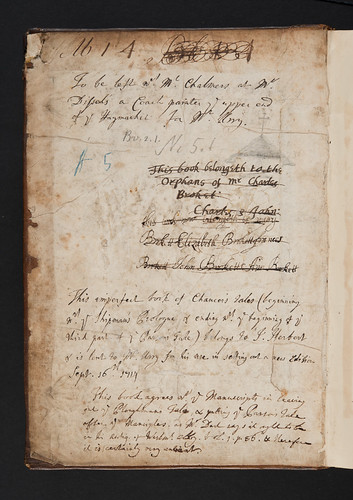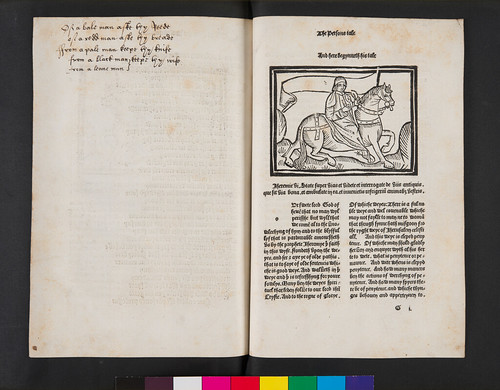Chaucer, Geoffrey: The Canterbury Tales.
[London]: Richard Pynson, [between June 1491 and 13 Nov. 1492]
Fol. a-v8 aa-kk8 ll6 A-I8 K6. [324] leaves (K6 blank).
Woodcuts; woodcut printer’s device.
ISTC ic00433000; GW 6587; Goff C433; BMC XI 264 (IB. 55484); Bod-inc C-173.
Two copies held by the University of Glasgow.
Copy 1
| GIP number: | C33/1 |
| Shelf-mark: | Sp Coll Hunterian Bv.2.1 (see main library entry for this item) |
| Variant: | The setting of H2v of this copy conforms to that of the two corrected copies in the British Library, except that in the first line of H2v, col. 1, this copy reads “... Cryſt ...”, not “... Cryste ...” as in the BMC transcription, and in the second line “... ſone ...”, not “... soue ...”. |
| Provenance: | William Sonnyng (fl. late 15th/early 16th century): inscription on m7r “Guill[aum]e Sonnyng demourant a Tournay [...]”, who is probably to be identified with William Sonnyng, alderman of English-occupied Calais, who was the owner of two manuscripts: an early 14th-century Livre de gouvernement des rois et des princes [a French translation of Giles of Rome’s De regimine principum] (Pierpont Morgan Library MS M. 122) and a late 15th-century Libel of English policy [with other texts] (Boston Public Library MS 1519). Jack Cade (16th century): name “Jack Cade” on kk1v. Sir John Arundell (16th century), of Trerice, Cornwall: partially read inscription on ii8v “Jo bart Arundell of Treris of [...]”. Baptist Jonson (17th century): name on ff8v “Baptist Jonson”. Brokett family (late 17th/early 18th century): inscription (lightly scored through) on front pastedown “This book belongeth to the orphans of Mr Charles Broket: Charles & John: this book now belongeth to Mary Brokett Elizabeth Brokett Frances Brockett John Brockett Ann Brockett”; name on r5r “Ann Brokett”. John Michell (late 17th/early 18th century): name on o8r “John Michell”. J. Herbert (fl. 1714): inscriptions on front pastedown “To be left w[i]th Mr Chalmers at Mr Dissel’s a coach painter ye upper end of ye Haymarket for Mr Urry” and “This imperfect book of Chaucer’s Tales (beginning w[i]th ye Shipman’s Prologue & ending w[i]th ye beginning of ye third part of ye Parson’s Tale) belongs to J. Herbert & is lent to Mr Urry for his use in setting out a new edition Sept. 16th 1714”. John Urry (1666-1715), literary editor: see above; Urry’s edition of Chaucer’s works appeared in 1721. William Hunter (1718-1783), physician and anatomist: source unknown. University of Glasgow: Hunterian bequest 1807; Hunterian Museum bookplate on front free endpaper; former Hunterian shelfmark “N.5.1” in pencil on front pastedown. |
| Binding: | England, 17th-century calf; covers decorated with a border of double fillets in blind; red-edged leaves; remains of two ties composed of strands of green wool; front free endpaper is a 19th or 20th-century addition. Size: 285 x 200 mm. |
| Leaf size: | 280 x 195 mm. |
| Annotations: | Inscription in a 16th-century hand at the beginning of the Wife of Bath’s prologue on s2r "thowghe sum whemen be blamyd all hath not afended prays them that goode be the best may be amended"; textual annotations in an early 18th-century hand in quires b-d and g (perhaps Urry’s - see Provenance); tipped onto the front free endpaper is a sheet of paper containing notes by William Hunter on this and other editions; two 18th-century(?) shelfmarks on front pastedown “U 1 4” and “Bl(?) 1 4” (the latter heavily scored through); number “f5” in blue crayon on front pastedown. |
| Decoration: | None. |
| Imperfections: | Wanting a8, b1-2, e3, t8, v1, ee2, ee7, A4-5, K1, K4-6. Leaves b7, r4, aa5, bb8, kk7-8 mutilated with loss of text. |
Copy 2
| GIP number: | C33/2 |
| Shelf-mark: | Sp Coll Hunterian Bv.2.12 (see main library entry for this item) |
| Variant: | The setting of H2v of this copy conforms to that of the two corrected copies in the British Library, except that in the first line of H2v, col. 1, this copy reads “... Cryſt ...”, not “... Cryste ...” as in the BMC transcription, and in the second line “... ſone ...”, not “... soue ...”. |
| Provenance: | John Boule (16th century): name “John Boule” on K6v. Frederick Lewis, Prince of Wales (1707-1751), owner(?): what appear to be his embossed arms (approximately 132 x 110 mm) are visible beneath the front pastedown. John Ratcliffe (1707-1776), book collector: lot 996 in Bibliotheca Ratcliffiana (1776). William Hunter (1718-1783), physician and anatomist: purchased by Hunter for £2.4.0 at the Ratcliffe sale according to the annotated British Library copy of the Ratcliffe sale catalogue (shelfmark 822.d.6). University of Glasgow: Hunterian bequest 1807; Hunterian Museum bookplate and book label with former shelfmark “Aa.5.21”. |
| Binding: | England, mid 18th-century gold-tooled red goatskin; covers have a dentelle border formed by an outer saw-tooth roll and repeated impressions of an arched tool incorporating an insect (bee or wasp?) with a backward-looking bird perched on top of each arch; the same border appears on the covers of three other English incunables previously owned by Ratcliffe and now in the Hunterian Library: (1) John Lydgate, The Life of Our Lady. [Westminster]: William Caxton, [1483] (L42, shelfmark Bv.2.20); (2) Ranulphus Higden, Polycronicon. [Westminster]: William Caxton, [between 2 July and 8 Oct. 1482] (H28, shelfmark Bv.2.9); (3) Gossuin de Metz, Myrrour of the worlde. [Westminster]: William Caxton, [ca. 1489-90] (G41, shelfmark Bv.2.30); gold-tooled spine; dark blue pastedowns; embossed arms visible beneath front pastedown (see Provenance); gilt-edged leaves. See also Christie’s Wentworth sale (8 July, 1998), lot 5 (Le doctrinal de sapience, Westminster: Caxton, [after 7 May 1489]), for a binding with identically tooled covers. Size: 275 x 192 mm. |
| Leaf size: | 267 x 186 mm. |
| Annotations: | Frequent manicules; on bb1v and bb2r are marginal references to Seneca, De ira, in a 16th-century hand; on F8v is a rhyme in a different 16th-century hand: “Of a bale man aske thy reede of a redd man aske thy breade From a pale man keepe thy knife from a black man/from a leane man keepe thy wife”. On K5v and K6r are manuscript verses in Latin in a humanist hand in praise of King Henry VII and his son, Arthur Prince of Wales, by Thomas Saint (from 1500-1513 Archdeacon of St. Davids, Wales) ending “Thomas stirpe satus britonu[m] cognomine sanctus Spiritus ut docuit celicus hec cecinit” (for the author see: C.G. Thomas Graham, ‘A lost manuscript of Thomas Saint, archdeacon of St. Davids, 1500-1513’, National Library of Wales Journal, vol. 24 (1986), pp. 309-338). |
| Decoration: | None. |
| Imperfections: | None. |











